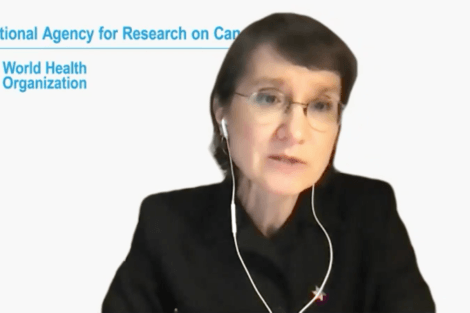December 15, 2020 – A wide range of environmental factors—including individual chemicals, complex mixtures, occupational exposures, physical agents, and biological agents—as well as personal habits, can increase people’s risk of developing cancer. For the past 50 years, the World Health Organization’s International Agency for Research on Cancer (IARC) has been keeping tabs on which hazards are the riskiest.
IARC Director Elisabete Weiderpass talked about the agency’s work and its monograph series, which provides comprehensive evaluations of existing data on carcinogens, at Harvard T.H. Chan School of Public Health’s Cutter Lecture in Preventive Medicine, held online December 11, 2020.
Weiderpass noted that cancer is predicted to become the leading cause of premature death in most countries in the 21st century, with low- and middle-income countries seeing the biggest increases. In addition, data suggests that cancer cases will increasingly be linked to environmental factors.
To identify these hazards, IARC gathers working groups of scientists to review and evaluate existing literature on possible carcinogens, she said. The scientists take into account key characteristics of human carcinogens, such as whether a substance alters DNA, induces chronic inflammation, or affects cells. The experts then group each substance into one of several categories, including carcinogenic, probably carcinogenic, possibly carcinogenic, or not classifiable.
Over the years, more than 1,000 agents have been evaluated in the IARC monographs program, and nearly 500 have been identified as known, probable, or possible carcinogens, Weiderpass noted. Some well-known agents that the IARC has deemed carcinogenic include tobacco, alcohol, radon, asbestos, and outdoor air pollution.
International health agencies can use information from the IARC monographs—known as the “World Health Organization encyclopedia of carcinogens”—to help decide on actions to prevent exposures to known carcinogens and on the implementation of cancer-prevention strategies, she said. Individuals can also use the information to make choices that will help reduce their cancer risk.
Experts regularly recommend new agents for IARC review, and Weiderpass noted that one of the top priorities for the near future will be a review of the data on flame retardants and pesticides.
The Cutter lecture has been held at Harvard Chan School since 1912, supported by a bequest from John Clarence Cutter, a graduate of Harvard Medical School. Albert Hofman, chair of the Department of Epidemiology, introduced Weiderpass and, at the end of her lecture, presented her—virtually—with a plaque in appreciation for delivering the lecture.
